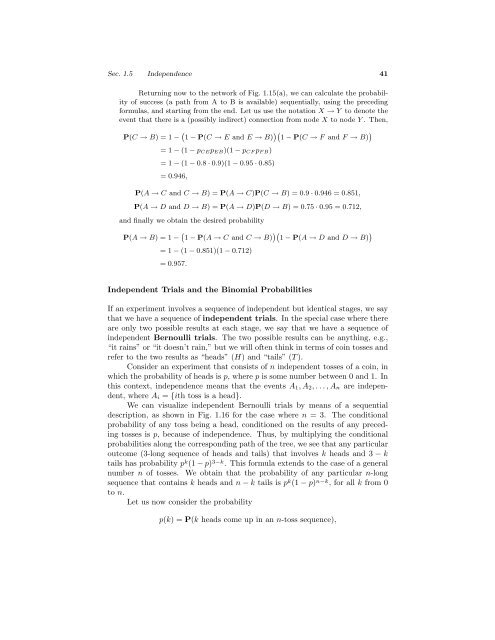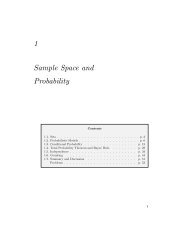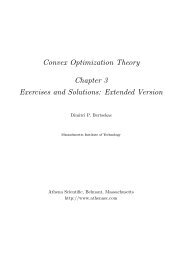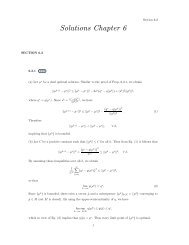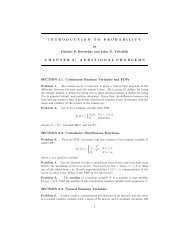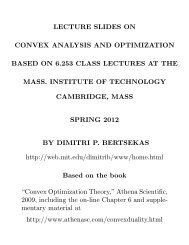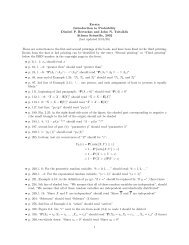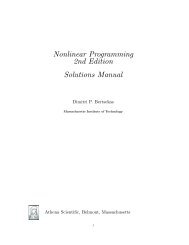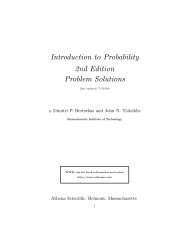Introduction to Probability, by Dimitri P ... - satrajit mukherjee
Introduction to Probability, by Dimitri P ... - satrajit mukherjee
Introduction to Probability, by Dimitri P ... - satrajit mukherjee
Create successful ePaper yourself
Turn your PDF publications into a flip-book with our unique Google optimized e-Paper software.
Sec. 1.5 Independence 41<br />
Returning now <strong>to</strong> the network of Fig. 1.15(a), we can calculate the probability<br />
of success (a path from A <strong>to</strong> B is available) sequentially, using the preceding<br />
formulas, and starting from the end. Let us use the notation X → Y <strong>to</strong> denote the<br />
event that there is a (possibly indirect) connection from node X <strong>to</strong> node Y . Then,<br />
P(C → B) =1− ( 1 − P(C → E and E → B) )( 1 − P(C → F and F → B) )<br />
=1− (1 − p CEp EB)(1 − p CFp FB)<br />
=1− (1 − 0.8 · 0.9)(1 − 0.95 · 0.85)<br />
=0.946,<br />
P(A → C and C → B) =P(A → C)P(C → B) =0.9 · 0.946 = 0.851,<br />
P(A → D and D → B) =P(A → D)P(D → B) =0.75 · 0.95 = 0.712,<br />
and finally we obtain the desired probability<br />
P(A → B) =1− ( 1 − P(A → C and C → B) )( 1 − P(A → D and D → B) )<br />
=1− (1 − 0.851)(1 − 0.712)<br />
=0.957.<br />
Independent Trials and the Binomial Probabilities<br />
If an experiment involves a sequence of independent but identical stages, we say<br />
that we have a sequence of independent trials. Inthe special case where there<br />
are only two possible results at each stage, we say that we have a sequence of<br />
independent Bernoulli trials. The two possible results can be anything, e.g.,<br />
“it rains” or “it doesn’t rain,” but we will often think in terms of coin <strong>to</strong>sses and<br />
refer <strong>to</strong> the two results as “heads” (H) and “tails” (T ).<br />
Consider an experiment that consists of n independent <strong>to</strong>sses of a coin, in<br />
which the probability of heads is p, where p is some number between 0 and 1. In<br />
this context, independence means that the events A 1 ,A 2 ,...,A n are independent,<br />
where A i = {ith <strong>to</strong>ss is a head}.<br />
We can visualize independent Bernoulli trials <strong>by</strong> means of a sequential<br />
description, as shown in Fig. 1.16 for the case where n =3. The conditional<br />
probability of any <strong>to</strong>ss being a head, conditioned on the results of any preceding<br />
<strong>to</strong>sses is p, because of independence. Thus, <strong>by</strong> multiplying the conditional<br />
probabilities along the corresponding path of the tree, we see that any particular<br />
outcome (3-long sequence of heads and tails) that involves k heads and 3 − k<br />
tails has probability p k (1 − p) 3−k . This formula extends <strong>to</strong> the case of a general<br />
number n of <strong>to</strong>sses. We obtain that the probability of any particular n-long<br />
sequence that contains k heads and n − k tails is p k (1 − p) n−k , for all k from 0<br />
<strong>to</strong> n.<br />
Let us now consider the probability<br />
p(k) =P(k heads come up in an n-<strong>to</strong>ss sequence),


